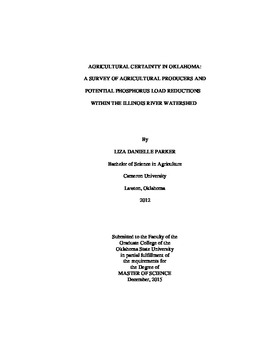| dc.description.abstract | Agricultural certainty is a growing concept in the United States. An agricultural certainty program is a voluntary program, where agricultural producers receive a whole farm conservation plan, implement the recommended conservation practices, and then can choose to sign an agreement with state and/or federal partners agreeing to maintain the implemented conservation practices for a specified amount of time. In exchange, the producer receives �certainty� that they will not be required to implement any additional practices for the length of the agreement if additional state and/or federal regulations are enacted (Natural Resources Conservation Service, 2011). The purpose of this study was to research the willingness of agricultural producers in the State of Oklahoma to participate in a certainty program. To determine willingness, a survey was developed and distributed to agricultural producers in Oklahoma. Although the survey had a low number of responses, it was determined that there is an interest within the agricultural community for a program. Additionally, this study explored the potential phosphorus (P) load reductions associated with best management practice (BMP) implementation on agricultural fields to simulate the P reductions that an individual producer could potentially have within the Illinois River watershed. Based on an existing study of the Illinois River watershed using the Soil and Water Assessment Tool (SWAT), average P load reductions between 7 and 28% were predicted from no overgrazing and litter export on pasture (Storm & Mittelstet, 2014). This study also used the Texas Best Management Practice Evaluation Tool (TBET) to predict Phosphorus (P) reductions from pasture fields for various management practices, which include no overgrazing, riparian buffers and cattle exclusion. Phosphorus reductions of up to 92% could be achieved on overgrazed pasture land, and 83% on well-managed pasture land through the implementation of riparian buffers, proper grazing, and cattle exclusion in the Illinois River watershed. Based on survey responses and potential phosphorus load reductions, the State of Oklahoma, and watersheds like the Illinois River watershed could benefit from the creation of an agricultural certainty program. | |
